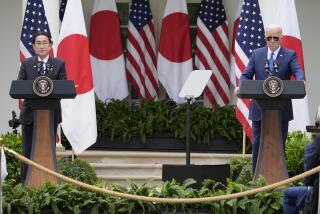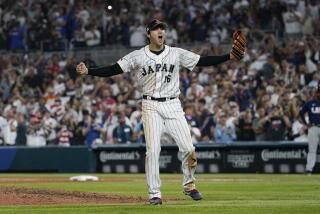Time for the Two to Get Real : Tokyo, Washington heading for deep trouble
- Share via
The U.S.-Japan summit is a ritual that has become tiresome in its ceremony and virtually meaningless in its results.
There is little reason to expect at this point anything hugely better from today’s first summit between President Clinton and Prime Minister Morihiro Hosokawa. But to allow the summit to end with nothing more than the usual vague promises and photo opportunity with smiles and handshakes would set back U.S.-Japan relations.
The United States is taking an uncharacteristically firm line with Japan under the Clinton Administration, which is seeking a results-oriented trade policy. U.S. rhetoric has been screechy chalk on the blackboard at times, but Washington’s rising frustration with Japan is shared by many American businesses and Japan watchers. After the signing of nearly 30 U.S.-Japanese trade agreements since 1980, the U.S. trade deficit with Japan is up to an intolerable $60 billion. Will this gap never lessen?
The challenge for Clinton and Hosokawa is to move trade relations beyond the traditional papering over of differences. The two men thrive on political brinkmanship and pride themselves on being agents of change. Now’s the chance to achieve change.
The “framework” agreement signed last July by Clinton and then-Prime Minister Kiichi Miyazawa calls for the President and the prime minister to meet every six months to review progress in trade talks. Today’s meeting is on automobiles and auto parts, medical equipment, telecommunications and insurance.
The impasse in the series of talks is over the definition of “objective criteria” for measuring imports into Japan. The Japanese contend that Washington is demanding specific, numerical targets for imports--in other words, managed trade. That should not be U.S. policy; the idea is contrary to free trade principles. American trade negotiators repeatedly claim that they have not used the terms numerical targets or managed trade. Therein lies the wiggle room for a compromise that saves face on both sides.
U.S.-Japan relations may not have advanced during Hosokawa’s roller coaster first six months in office, but he did win important political reforms, lift the rice import ban and wedge open the construction market. He got the Parliament to enact an economic stimulus plan, though the $140-billion program was far from everything he and Clinton wanted. The reformist Hosokawa favors deregulation, open markets and a more consumer-oriented economy--all of which serve both U.S. interests and Japanese consumers’ interests.
Clinton may not be taking the best, most coherent approach to this divisive issue, but it should now be clear to the Japanese that he means business. Tokyo should not underestimate the new American resolve.
More to Read
Inside the business of entertainment
The Wide Shot brings you news, analysis and insights on everything from streaming wars to production — and what it all means for the future.
You may occasionally receive promotional content from the Los Angeles Times.










